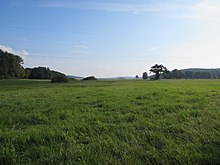Marzahner Fenn
The Marzahner Fenn in the Marzahner Glacier Tongue Basin is a valley or wetland in the Potsdam-Mittelmark district that was formed during the Ice Age . It lies between the city of Havelsee and the communities of Beetzsee and Beetzseeheide . The valley floor marks the border between Havelsee and the communities.
History of origin
The Marzahner Fenn came into being after the last, the Vistula Ice Age . It is a shallow glacier tongue basin. It was shaped following the direction of advance of the inland ice from northeast to southwest. The sides of the glacier tongue basin are flanked by hilly compression moraine complexes of the Nauener Platte , some of which rise to over seventy meters. To the southwest, the advancing ice lifted the compression moraine complex of the 89.3 meter high Black Mountain , which closes the valley like a bar. Since the valley had no natural drainage to the nearby parallel glacial valley of the Havel or the Beetzseerinne , the marshy wetland of the Marzahner Fenn could develop. The Marzahner Fenn is not to be confused with the White Fenn Marzahne , a wetland about two kilometers to the northwest, which formed in the area of an ice age meltwater channel.
Marzahner Fenn and Dünenheide nature reserve
The Marzahner Fenn is part of the nature reserve Marzahner Fenn and Dünenheide. This 725 hectare nature reserve is located next to in Havelsee, Beetzsee and Beetzseeheide in the north on areas of the municipality of Märkisch Luch . It is characterized by a close spatial relationship between different living spaces. There are near-natural alder and pine forest communities on nutrient-poor locations, bodies of water, slight mountain ranges with only extensively used dry valleys, so-called dwarf shrub and dune heaths, small fens, wet meadows and wet meadows. Due to the different habitats, a large number of partly endangered plant, bird, reptile and amphibian species live in the protected area. According to the German Nature Conservation Union , 78 of the 156 vertebrate species found in the Marzahner Fenn and Dünenheide are considered endangered. The area represents an ecological link between the Beetzsee and Riewendsee in the east, the Havelniederung in the west and the Havelländischer Luch in the north. Some of the animal and plant species living in the nature reserve are osprey, spotted eagle , tree falcon , snipe, quail , crane, great gray shrike, sand lizard , grass snake , spadefoot , moor frog , newt , purple loosestrife and milfoil . The nature reserve Marzahner Fenn and Dünenheide is in its entirety part of the European bird sanctuary ( SPA area ) Middle Havel Lowlands and in the northern area part of the FFH area Weißes Fenn and Dünenheide. It is part of the European Natura 2000 network of protected areas . In addition, the Marzahner Fenn still is part of the conservation area, and the Westhavelland Nature Park and the protected landscape elements reported.
Russengraben and Torfstichsee
The so-called Russengraben was created by Russian prisoners of war as an artificial drain of the Marzahner Fenn in 1917 . This rises in the northeast of the valley and flows through it in its entire length. In the center of the valley it flows through a rectangular lake about one hectare in size, which was formed in a former peat cut . Three weirs were installed to control the water level and the runoff . The Marzahner Fenn is drained to the Beetzsee lake to the east . After the ditch was built, attempts were made from 1920 to reclaim the area of the fen. This was only partially successful.
use
The hilltops on the edge of the Fenn are overgrown with pine forests. The higher and correspondingly drier slopes are used for agriculture. In the past, peat was extracted in the valley floor . The wet meadows are mainly mowed and the hay is fed to cattle.
Individual evidence
- ↑ Sebastian children and Haik Thomas Porada (ed.): Brandenburg an der Havel and surroundings. 2006, p. 89.
- ↑ Geology. In: Landkreis Potsdam-Mittelmark landscape framework plan. Office for Environmental and Landscape Planning, archived from the original on May 3, 2015 ; Retrieved October 16, 2013 .
- ↑ Marzahner Fenn and Dünenheide nature reserve (PDF; 267 kB). Accessed October 16, 2013.
- ↑ Part sheet Northwest Protected Areas. In: Landkreis Potsdam-Mittelmark landscape framework plan. Office for Environmental and Landscape Planning, archived from the original on August 7, 2011 ; Retrieved October 16, 2013 .
- ↑ History of the "Russengraben" . Accessed July 18, 2014.
- ↑ Marzahner Fenn . Accessed July 18, 2014.
Coordinates: 52 ° 30 '6.88 " N , 12 ° 33' 6.16" E





